P
Peter Apps
P
Peter Apps
AP Physics C: E&M 💡
26 resourcesSee Units
The Ultimate AP® C: Electricity & Magnetism Exam Guide
A quick pep talk before we start
You've been (likely) prepping for months for this exam! 🤓 One test can never measure everything you've learned from studying physics. So please, don't let your AP scores define you!
Now that we've gotten that out of the way, let's focus a bit more on the actual exam.
Exam Logistics 🤔
The AP Physics C: EM exam (just like almost every other exam) consists of 2 sections: Multiple Choice Questions (MCQs) and Free-Response Questions (FRQs).
In Section 1, you will have 45 minutes to answer 35 MCQs, whereas, in Section 2, you will have 45 minutes to answer 3 FRQs, one of which will be an experimental based question. Each section is weighted at 50% of your exam score, so it's important to prepare for both sections! 📚
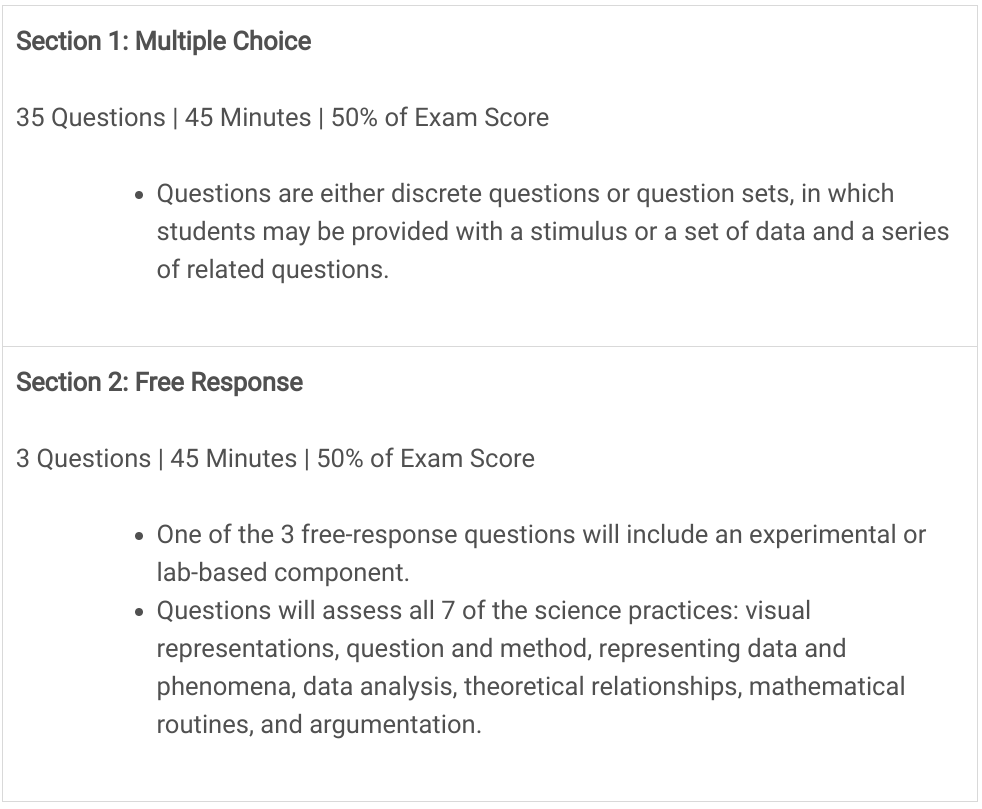
Image from AP Physics C: Exam Description
As far as trying to guess what topics will be on the exam, CollegeBoard has given us this rough estimate of how the questions will be broken down:
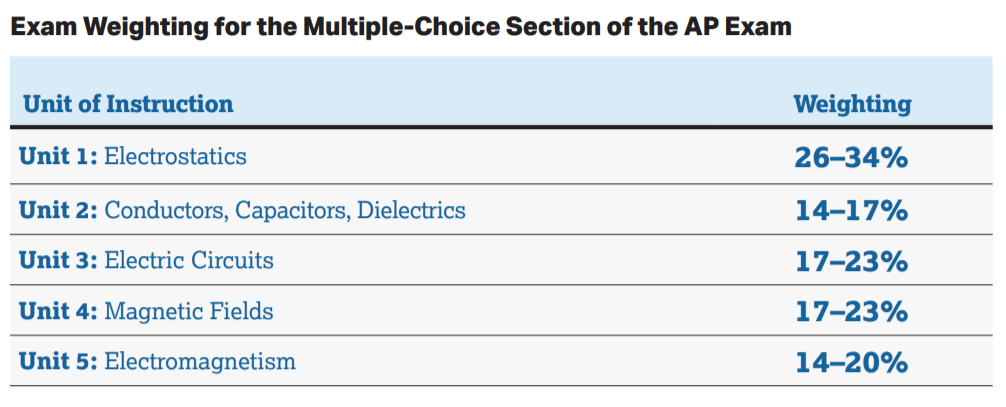
Image from AP Physics C: E&M Course & Exam Description
Section 1: Multiple Choice Questions
This section mostly consists of (you guessed it) Multiple Choice Questions. You're more likely to be asked a question about theoretical relationships, graph interpretation, or relating a given law to a situation than you are to be asked questions about experimental methods, or procedures.
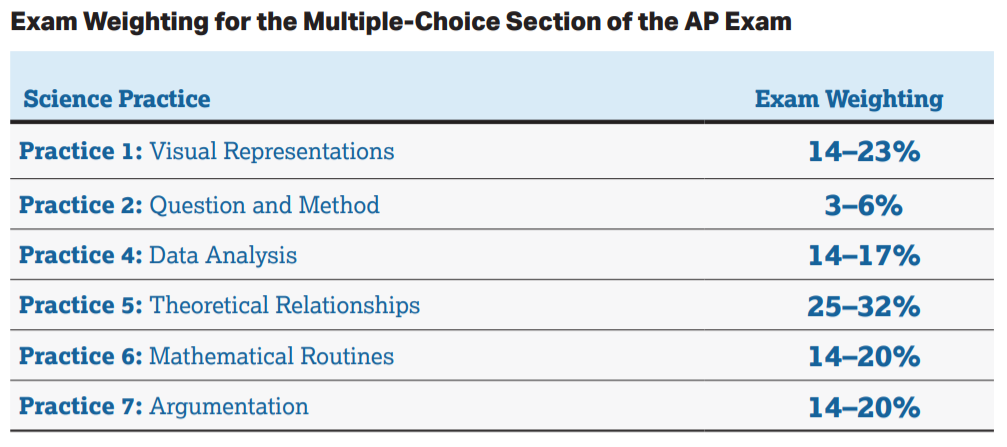
Image from AP Physics C: E&M Course & Exam Description
Strategies For the Multiple Choice Section 💪
- Read the question fully before trying to answer. There's often a tidbit in the image or description that is essential to correctly solve the problem. Don't just skim.
- It's ok to narrow down to 2 choices before guessing. CollegeBoard doesn't expect perfection and a 50% chance of getting the right answer is a lot better than leaving it blank.
- Reference Tables are your friend! Even if it's for something as simple as "What's the unit for charge?" It's a free resource so use it!
- Start with a question you know you'll get right! A little boost of confidence can be the difference between a very difficult test and one that's much easier.
- Watch your time! You've got about 75 seconds to answer each question. Don't feel bad about skipping a harder question and coming back to it if you have time. (Just make sure you don't leave any blanks on that answer sheet!)
Sample MC Questions
All of these questions can be found on the AP Physics C: E&M Course and Exam Description
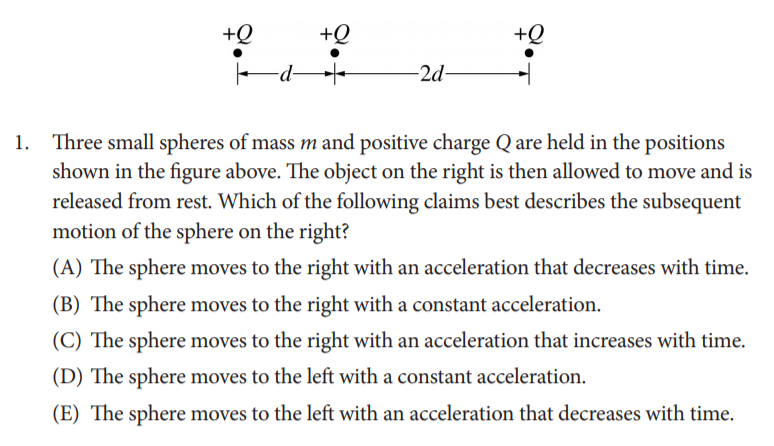
Answer:
1) A. The force on the sphere on the right is pointed to the right because all the charges are repelling each other. Fe ∝ 1/r^2 so as the distance between the spheres increases, the force and acceleration will decrease (Newton's 2nd Law).
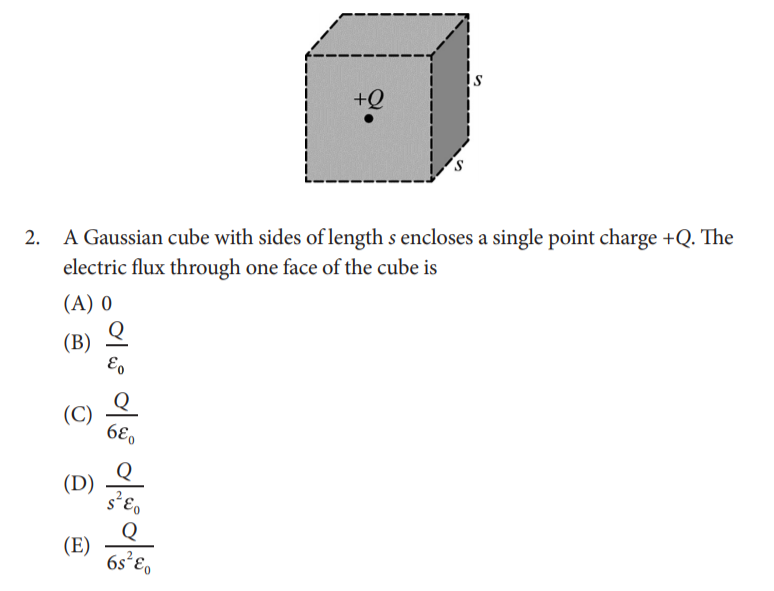
Answer:
2) C. Gauss's Law shows that the enclosed charge is proportional to the electric flux traveling through an area. The each side of the sphere is 1/6 the total area, so should have 1/6 of the total flux.
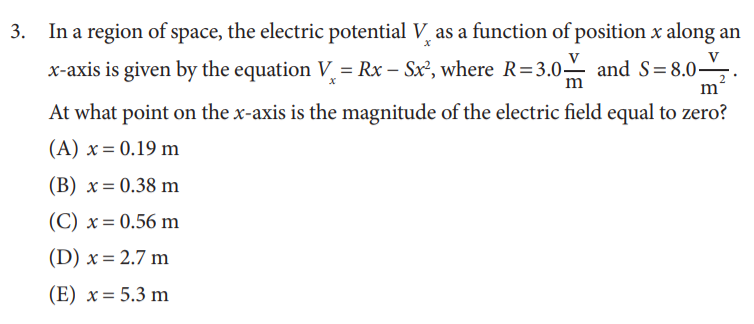
Answer:
3) A.


Answer:
9) D
Find the total current in the circuit, then use KVL:

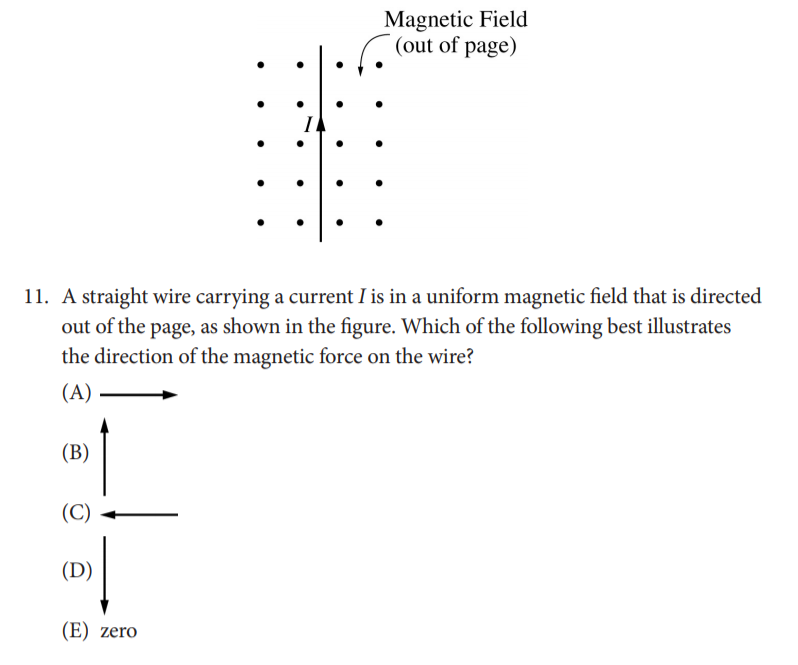
Answer:
11) A. Use the Right Hand Rule
Section 2: Free-Response Questions
So you've made it through the MCQ, now we've got ~15 minutes each to tackle 3 FRQ's. Unlike the MCQs, we know there will be at least one question here that's focused on experimental design.
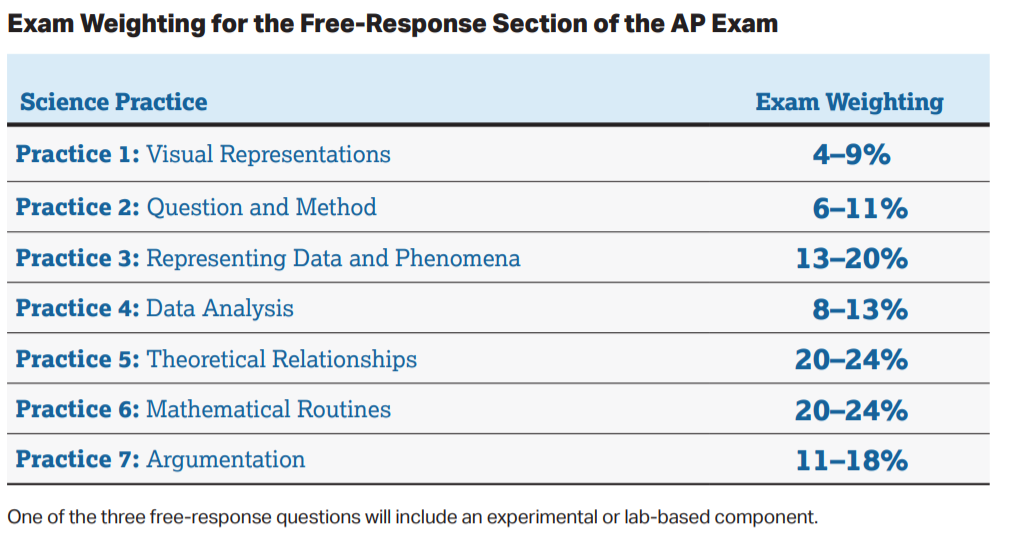
Notice that Practice 3: Representing Data shows up here, but wasn't in any of the MCQ questions. Be ready for drawing fields, graphs, and trajectories! Other than that, we're still focusing a lot on theoretical relationships and math routines. Don't be surprised if you end up doing more calculus in the FRQ's than you did in the MCQ's.
Strategies for the FRQ 🤨
- Pace yourself! You have 15 minutes per question and it goes by quickly.
- Graphs and drawings are easy points. If you're crunched for time and have to choose between a graph section or a derivation, choose the graph one!
- Reference tables are there for a reason! Use them!
- Circuits, Electric Fields, and Magnetic Fields are the 3 most often asked topics for these FRQ's. Be ready!
- Know your vocab! (Check out the list below)
- Vocab is fun!
- Calculate: Perform mathematical steps to arrive at a final answer, including algebraic expressions, properly substituted numbers, and correct labeling of units and significant figures. Also phrased as “What is?”
- Compare: Provide a description or explanation of similarities and/or differences.
- Derive: Perform a series of mathematical steps using equations or laws to arrive at a final answer.
- Describe: Provide the relevant characteristics of a specified topic.
- Determine: Make a decision or arrive at a conclusion after reasoning, observation, or applying mathematical routines (calculations).
- Estimate: Roughly calculate numerical quantities, values (greater than, equal to, less than), or signs (negative, positive) of quantities based on experimental evidence or provided data. When making estimations, showing steps in calculations are not required.
- Explain: Provide information about how or why a relationship, process, pattern, position, situation, or outcome occurs, using evidence and/or reasoning to support or qualify a claim. Explain “how” typically requires analyzing the relationship, process, pattern, position, situation, or outcome; whereas, explain “why” typically requires analysis of motivations or reasons for the relationship, process, pattern, position, situation, or outcome.
- Justify: Provide evidence to support, qualify, or defend a claim, and/or provide reasoning to explain how that evidence supports or qualifies the claim.
- Label: Provide labels indicating unit, scale, and/or components in a diagram, graph, model, or representation.
- Plot: Draw data points in a graph using a given scale or indicating the scale and units, demonstrating consistency between different types of representations.
- Sketch/Draw: Create a diagram, graph, representation, or model that illustrates or explains relationships or phenomena, demonstrating consistency between different types of representations. Labels may or may not be required.
- State/Indicate/Circle: Indicate or provide information about a specified topic, without elaboration or explanation. Also phrased as “What…?” or ”Would…?” interrogatory questions.
- Verify: Confirm that the conditions of a scientific definition, law, theorem, or test are met in order to explain why it applies in a given situation. Also, use empirical data, observations, tests, or experiments to prove, confirm, and/or justify a hypothesis.
Sample Free Response Questions
All of these questions can be found on the AP Physics C: E&M Course and Exam Description
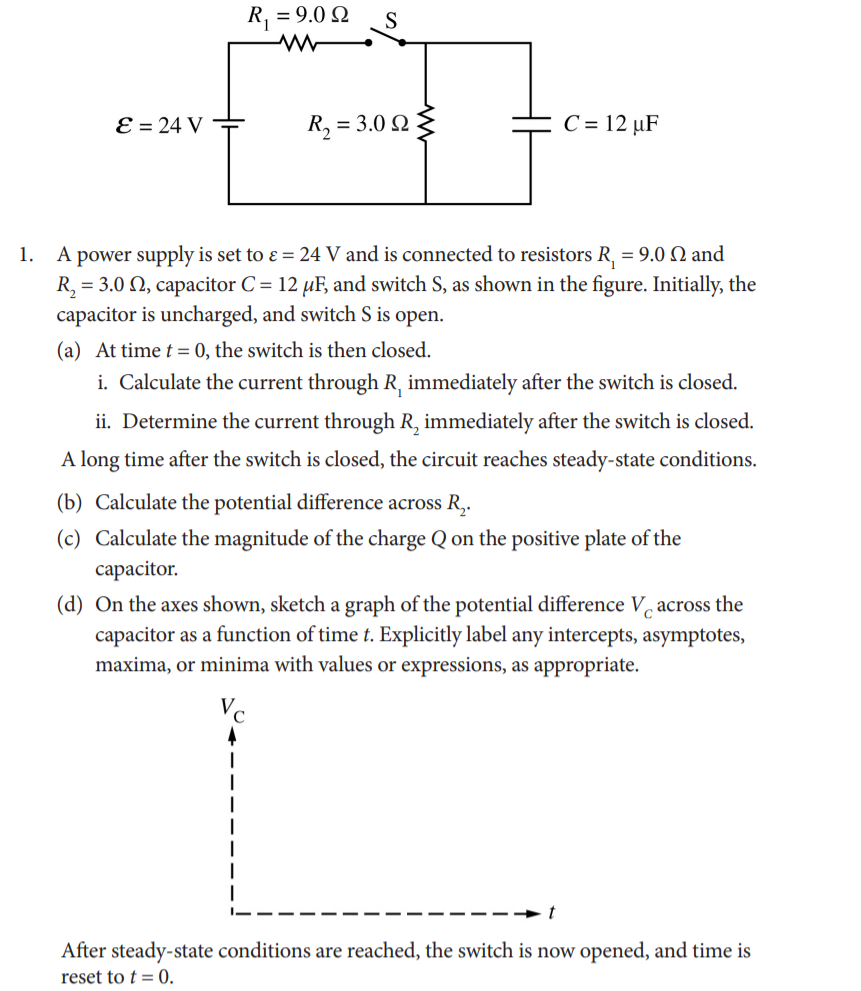
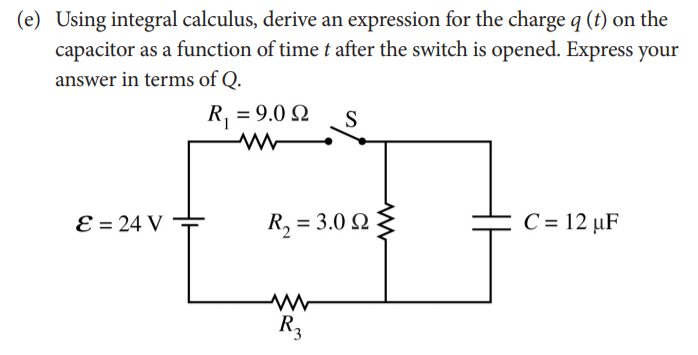
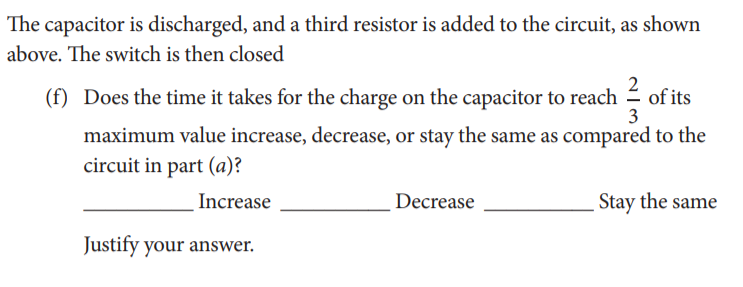
Answers:
a)
- i) The capacitor acts like a short circuit, so the current only flows through R1

- ii) Since the capacitor acts like a short circuit, no current flows through
b) In steady state, the capacitor acts like an open branch, so the circuit simplifies to a series circuit with R1 and R2.
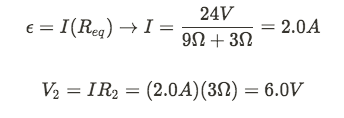
c) The capacitor is in parallel with R2 so their voltages must be equal.

d) Capacitor starts with 0V as it's uncharged, the grows and asymptotes with 6V

Image from AP Central
e) Ok here's the math question! With the switch open we only care about R_2 and the capacitor. Start with KVL and go from there
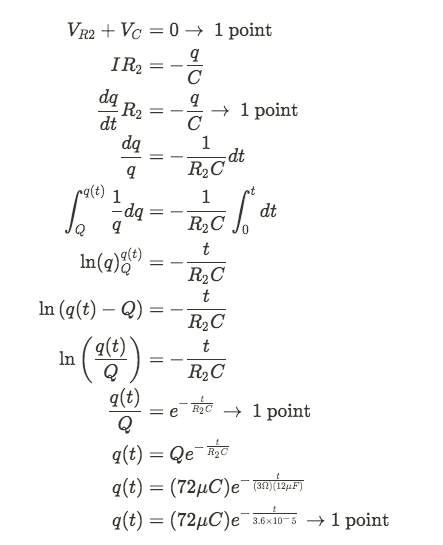
f) Adding R3 increases the total resistance of the circuit. Since the time to charge a capacitor depends on RC (the time constant), increasing R will increase the time constant, and therefore the capacitor will take longer to charge.
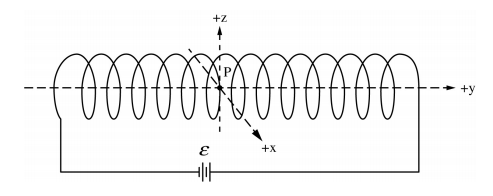
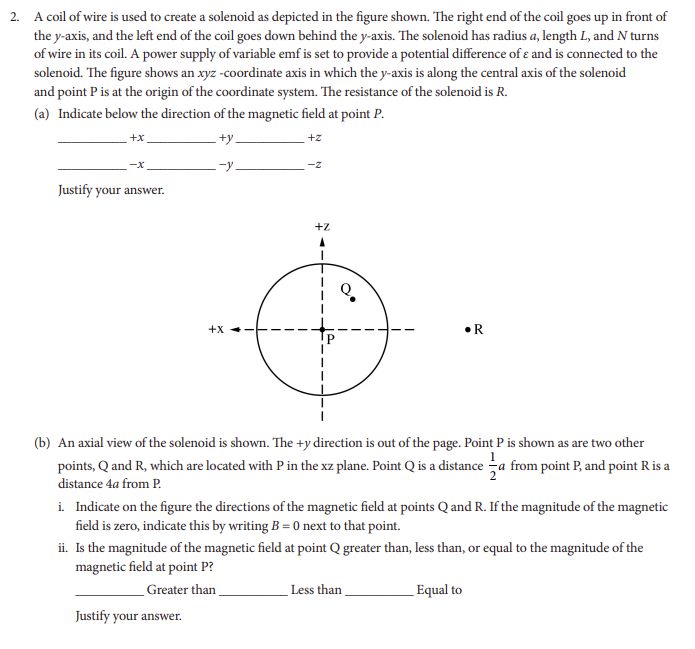
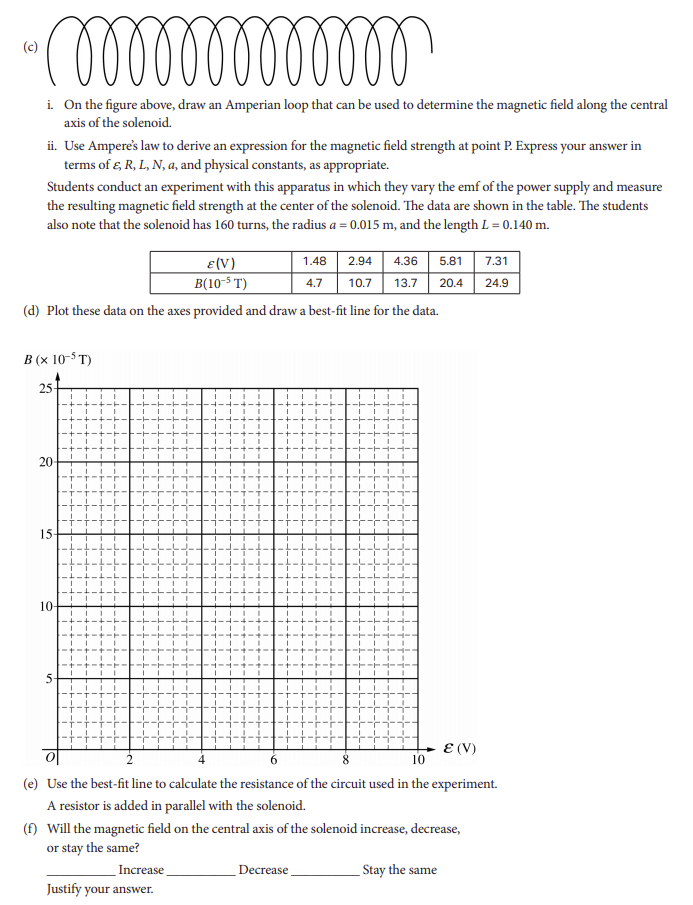
Answers:
a) The magnetic field at point P is pointing in the negative y direction. The current leaves the battery to the right and comes up in front of the coil and goes down behind the coil. Using the right-hand rule, if the current comes up in from of the coil, the magnetic field is directed to the left. This is the -y direction. (Refresher - Link)
b)
- i) For point Q, we've already said that the current loops around the coil, use the Right Hand Rule again. Point R is outside the coil, which means that it's magnetic field is basically 0.
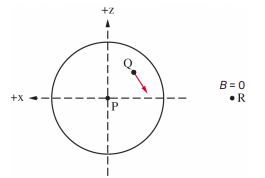
- ii) There are actually 2 possible answers for this, depending on if you consider the coil to be "long" or not. (Yay ambiguous descriptions!) The scoring guidelines give credit for both as long as you state that the coil is 'long' for the 2nd option.
- If you consider the coil to be short: For a coil of wire, the magnetic field is at a maximum at its center; thus, the magnetic field is less at point Q than at point P
- If the coil is "long": For a long solenoid, the magnetic field inside is basically constant, so the field at point P is equal to the field at point Q
c)
- i)

- ii)
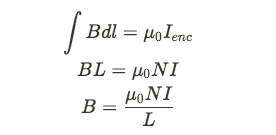
d) Be sure to label your axis correctly
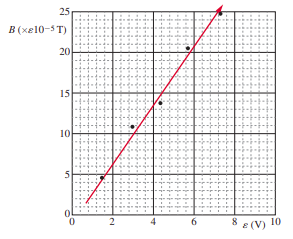
e) Take the answer to part (c) and apply Ohm's Law.

f) Adding the resistor in parallel does not change the current in the solenoid, so the magnetic field on the central axis will stay the same.
More Free Response Questions are available at College Board's website below!
Browse Study Guides By Unit
⚡️Unit 1 – Electrostatics
🔋Unit 2 – Conductors, Capacitors, Dielectrics
🔌Unit 3 – Electric Circuits
🧲Unit 4 – Magnetic Fields
⚛️Unit 5 – Electromagnetism
📚Study Tools
📚Exam Skills

© 2025 Fiveable Inc. All rights reserved.